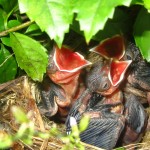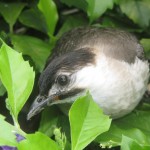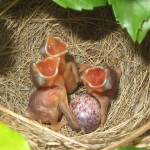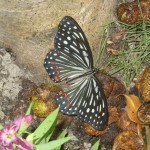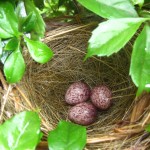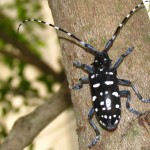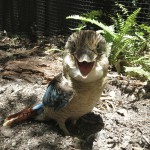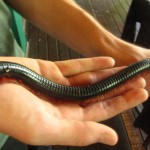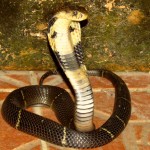Flora and Fauna of Tropical Asia
The fascinating world of tropical nature
Battle for Survival
Bad news – two of the baby bulbuls were lost yesterday afternoon. I don’t know if this was a case of the mother abandoning the two weakest individuals (I believe some birds to this in order to give the strongest ones a better chance to survive) or a result of predator activity. Given the fact that I found bits and pieces of the baby birds scattered on the lawn not too far from the nest, I am inclined to believe the latter. I had been especially concerned about a possible threat posed by the White-vented Myna (Acridotheres javanicus),… Continue reading
Meet the (Bulbul) Parents
I was finally able to take a few decent shots of the bulbul couple (Pycnonotus taivanus) that set up residence in low bushes right at the entrance of our house. I have taken more pictures of the female who seems to be the only one looking after the little ones. The male does show up from time to time, as if to assert his right over the territory around the nest, but otherwise leaves all the feeding duties to his companion. As one would imagine, the female bulbul gets very busy since feeding four hungry mouths does take… Continue reading
Taiwan Bulbul – Hatchlings
The eggs have hatched! Three of the four so far, the fourth one is still intact. The mother bulbul (Pycnonotus taivanus) has diligently incubated them during the past 11 days (despite frequent rains and even a few heavy thunderstorms) and it was such a pleasure to see the baby birds emerge this afternoon! I took just one photo before the mother returned to the nest and I photographed her too – amazingly she wasn’t frightened by me or the camera, even though I held it just 15 centimetres from her face. Maybe she was simply determined to protect… Continue reading
Red Ring Skirt Feeding on Fig
The Red Ring Skirt (Hestina assimilis) is a species of butterfly in the family nymphalidae, commonly found in Asia (from northern Vietnam to southern and eastern China as well as the Korean peninsula, Taiwan and southern Japan). Fairly large, with its wing span of 60 – 80 millimetres, it is an attractive insect that often feeds on the ground, looking for fallen decomposing fruit or a source of moisture. The larvae are commonly found on top of the leaves of the Chinese hackberry tree (Celtis sinensis), taking about three weeks to mature. The adult butterfly… Continue reading
Taiwan Bulbul – Eggs
The Taiwan Bulbul or Styan’s Bulbul (Pycnonotus taivanus) is an endemic species of bulbul that lives in eastern and southern Taiwan. These birds are very common around Taitung and often set up nests in the taller trees around our house. Recently, however, a pair of them has built theirs in the low bushes of Skyflower (Duranta erecta), right at the entrance of the house! I found this surprising as they must have noticed the rather heavy traffic of people walking in and out – now barely a metre from the nest! Also, the… Continue reading
Asian Long-horned Beetle
Asian Long-horned Beetle (Anoplophora glabripennis) is a spectacular insect, at least in terms of appearance. Its enormous antennae in alternating black and white colours are perhaps the most fascinating – without them it would look fairly ordinary. This is only the second time I spotted this insect in the garden; luckily this time it gave me enough time to get the camera and take some photos before it climbed up the tree and disappeared. The reason for it being so rare is the fact that, although it takes it two years to mature, its adult life then… Continue reading
Blue-winged Kookaburra
The Kookaburra is a stunning kingfisher found in northern and eastern Australia, the island of New Guinea and on Aru Islands in eastern Indonesia. Not only they look unusual with their comparatively large heads and contrasting feather colours, their call genuinly resembles loud human laughter. In fact, one of the four known species is commonly referred to as Laughing Kookaburra (Dacelo novaeguineae). There are also Rufous-bellied Kookaburra (Dacelo gaudichaud) and Spangled Kookaburra (Dacelo tyro). They are carnivorous birds that feed on mice and other similar-sized mammals, lizards and larger insects. And apparently they are… Continue reading
Borneo Giant Millipede
In Borneo, natural surprises await an unsuspecting visitor on every corner. The Borneo giant millipede (Trigoniulus) is a long invertebrate that can reach 20 centimetres in length and may have as many as 300 pairs of legs! Unlike many centipedes, which are nocturnal, carnivorous and often aggressive, this Borneo creature is a harmless, gentle giant of the rainforest – a vegetarian feeding mostly on soft decomposing plant tissue. A physiological difference between centipedes and millipedes is the fact that millipedes have two pairs of legs per segment of their bodies (unlike centipedes which have just one pair). They… Continue reading
Borneo Elephants
Borneo elephant (Elephas maximus borneensis) is a subspecies of elephant found in northeastern Borneo. Their origin is a matter of dispute – there have been suggestions that the mammal was introduced to the tropical island from peninsular Malaysia, but there are zoologists who believe that they developed separately from other Asian elephant species. As just about any large animal on the world’s third biggest island, these elephants are threatened due to shrinking rainforest which is apparently disappearing at a rate of 300 football fields every single hour! The forst is replaced with palm oil plantations, a monoculture made… Continue reading
Chinese Cobra on Visit
It’s the second time this year a Chinese cobra (Naja atra) has paid us a visit. The first time it happened I was mighty excited — and terribly scared — because it was making its way towards the aviary where I keep a handful of parrots. Although this was no King cobra, it was still deadly and I was worried. Eventually the snake did enter the aviary, although I only became aware of the fact four days later when I spotted it again – right next to the small refrigerator where I keep bird food. So for… Continue reading
